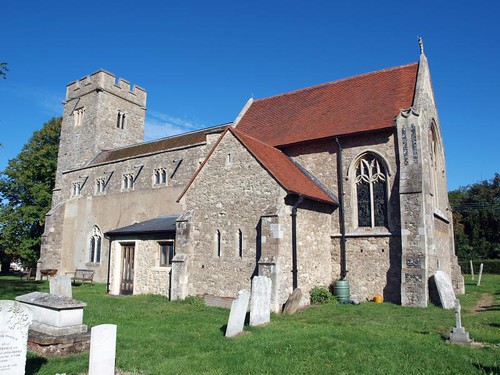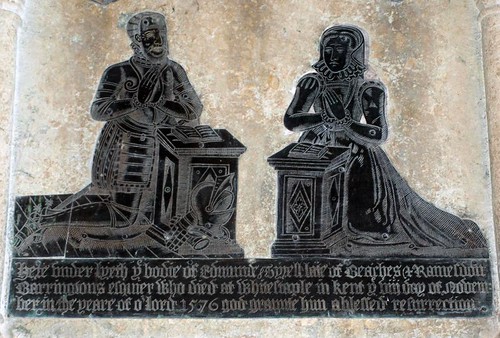ST NICHOLAS. 1882 to the design of the Rev. Ernest Geldart, rector of Little Braxted. A rather gaudy design with flushwork and, in the porch, even some flint, stone and red tile-work. W tower; chancel higher than nave. - MONUMENT. Brass to Edmund Tyrell d. 1576 and wife. Kneeling figures on stone tablet with side-columns and a round arch. In the decoration still Gothic motifs.
RAWRETH. It lies attractively on a byway, its tower seen afar in the undulating countryside. Except for this old tower, with its lions peering from the corners, and a 15th century arcade, the church was refashioned in 1882 from the designs of Ernest Geldart, rector of the tiny Norman church at Little Braxted. Its font has a modern bowl on a stem which once held a Norman one, and there is a fine screen watched over by a handsome nave roof. A Tudor monument in the south aisle has brasses of Edmund Tyrell and his wife on a stone richly carved. From the porch St Nicholas looks out on this corner of Essex where a foreign king is believed to have fought his last battle for English soil, for we are not far from what is still called Battlesbridge on the River Crouch, and it was hereabouts that Canute, after a long and terrible fight, defeated Edmund Ironside. Where the tall mills now stand by the river the Danish ships are thought to have been drawn up, waiting for the result of a battle which influenced the whole course of our island story.
Simon K -
Leaving Rayleigh to the west, it was a short distance into the countryside to Rawreth. St Nicholas sits broadside on to the village street. The outer gates were hooked back, the inner door was wedged open with a lump of stone. 'Welcome to your church', said the sign on door.
This is an interesting church, because it was substantially rebuilt by Ernest Geldart who we have met before at, among others, Great Totham and Great and Little Braxted. Only the tower and arcade are medieval.
Geldart is interesting because he used medieval forms from non-ecclesiastical buildings to create worship spaces for extremely high Anglo-Catholic liturgy. That tradition has gone here now, but the fixtures and fittings survive - just.
There was a massive restoration 1986-90 which cost £75,000, but already the south chancel wall is collapsing, and the floor of the sanctuary breaking up, all the tiles coming loose. It is hard to see how they will rescue it. There are murmurings of redundancy, but it simply isn't a significant enough church for the CCT to take it on.
Thoughts provoked, I left the narrow band of countryside and, re-entering urban sprawl, came to Wickford.
Simon K -
Leaving Rayleigh to the west, it was a short distance into the countryside to Rawreth. St Nicholas sits broadside on to the village street. The outer gates were hooked back, the inner door was wedged open with a lump of stone. 'Welcome to your church', said the sign on door.
This is an interesting church, because it was substantially rebuilt by Ernest Geldart who we have met before at, among others, Great Totham and Great and Little Braxted. Only the tower and arcade are medieval.
Geldart is interesting because he used medieval forms from non-ecclesiastical buildings to create worship spaces for extremely high Anglo-Catholic liturgy. That tradition has gone here now, but the fixtures and fittings survive - just.
There was a massive restoration 1986-90 which cost £75,000, but already the south chancel wall is collapsing, and the floor of the sanctuary breaking up, all the tiles coming loose. It is hard to see how they will rescue it. There are murmurings of redundancy, but it simply isn't a significant enough church for the CCT to take it on.
Thoughts provoked, I left the narrow band of countryside and, re-entering urban sprawl, came to Wickford.


No comments:
Post a Comment